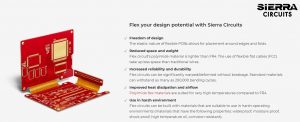Rigid Flex Circuit Boards
Rigid-flex circuit boards combine the rigidity of traditional PCBs with the flexibility of flexible printed circuits (FPC). They can be airborne or submerged, and used in a variety of situations that require both rigidity and flexibility. Rigid-flex circuit boards can also be more compact than their rigid counterparts, making them ideal for space-efficient electronic devices. With advances in materials and manufacturing techniques, future developments could see even greater miniaturization and enhanced flexibility for rigid-flex circuit boards.
The rigid and flexible sections of a rigid flex board are connected through interconnects such as copper wires and through vias. To ensure reliable interconnections, designers must choose the right materials for their projects and account for factors like thermal stability and electrical properties. This requires balancing flexibility and rigidity in the design, as well as selecting materials that can be bent to the appropriate radius without compromising structural integrity or signal strength.

Copper is the preferred conductor material for rigid-flex circuit boards due to its excellent electrical properties and availability in various thicknesses, sizes, and weights. Rigid-flex circuit boards can be made using electro-deposited copper foil or rolled copper, and can be treated to improve adhesion, increase strength, and enhance corrosion resistance. Rigid-flex circuit boards should be plated with nickel and copper to guarantee proper contact between layers and allow for effective signal transmission and electromagnetic interference (EMI) shielding.
How Rigid Flex Circuit Boards Are Made
Once the conductors are in place, pads and traces are routed according to the product design, and the flexible portions are etched using either laser or mechanical drilling techniques. The etching process also removes the top layer of the cover lay, which is then laminated with a polyimide film to protect the copper layers. Finally, a copper plating process is applied to the plated through holes and through-holes on the rigid-flex circuit boards to establish an electrical connection between the different layers.
When a rigid-flex circuit board is completed, it is ready to be assembled into the final product. Unlike conventional PCBs that use wired interconnects, a rigid-flex circuit board can be tested for continuity and connectivity at this stage, eliminating the need for a wiring job in the product’s housing, which saves time and money and reduces the risk of errors in the assembly process.
Rigid-flex circuit boards are used in a wide range of applications, from industrial automation to the energy sector. They are particularly useful in the aerospace and defense industries, where reliability is a crucial consideration. They can be manufactured to withstand harsh environmental conditions, including vibrations and electromagnetic interference (EMI). The ability of rigid-flex circuit boards to accommodate varying temperature ranges, and to dissipate heat effectively, make them a good option for renewable energy systems like wind turbines and solar panels. A rigid-flex PCB can also help ensure the safety of these systems by detecting and responding to any malfunction or damage.